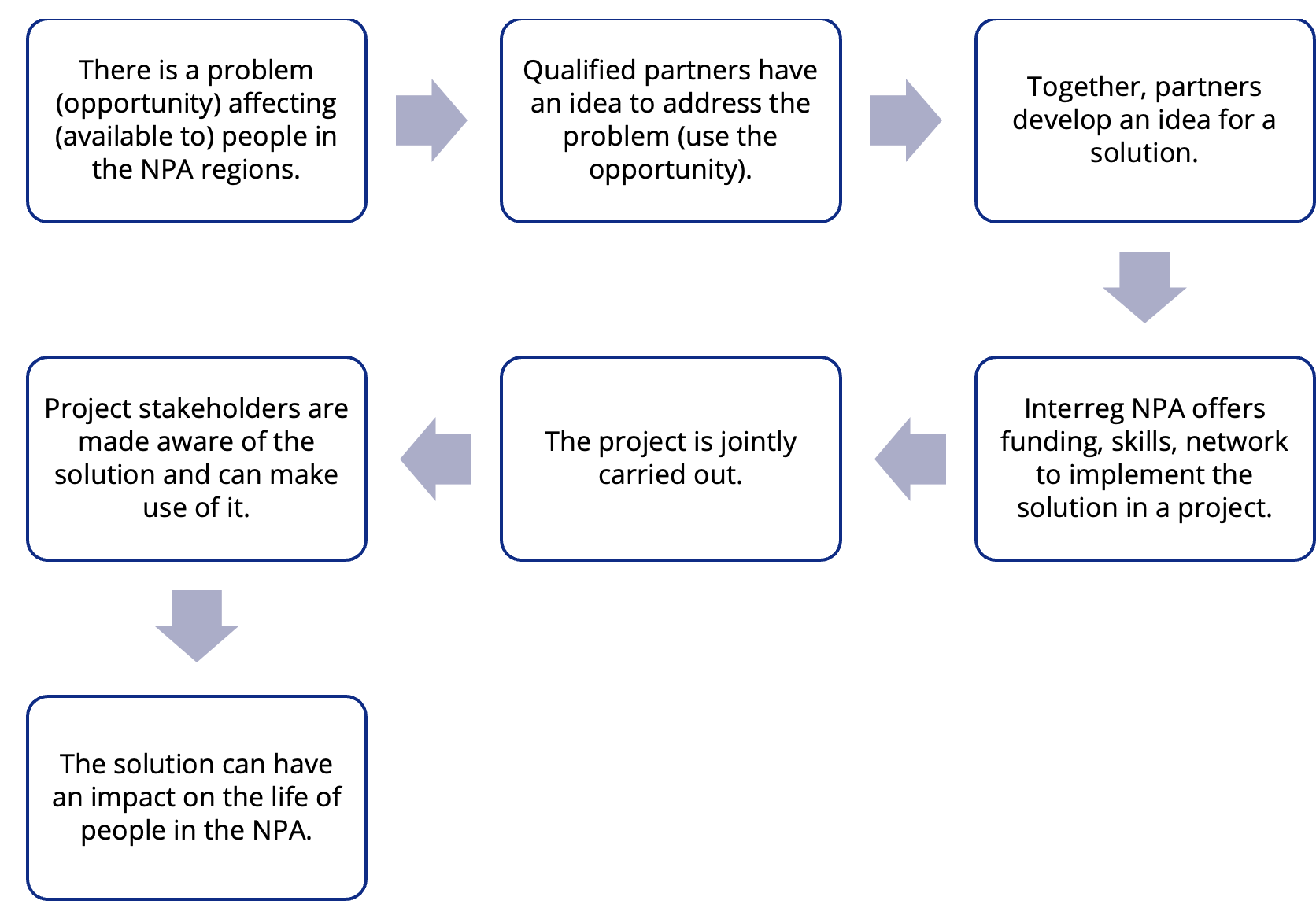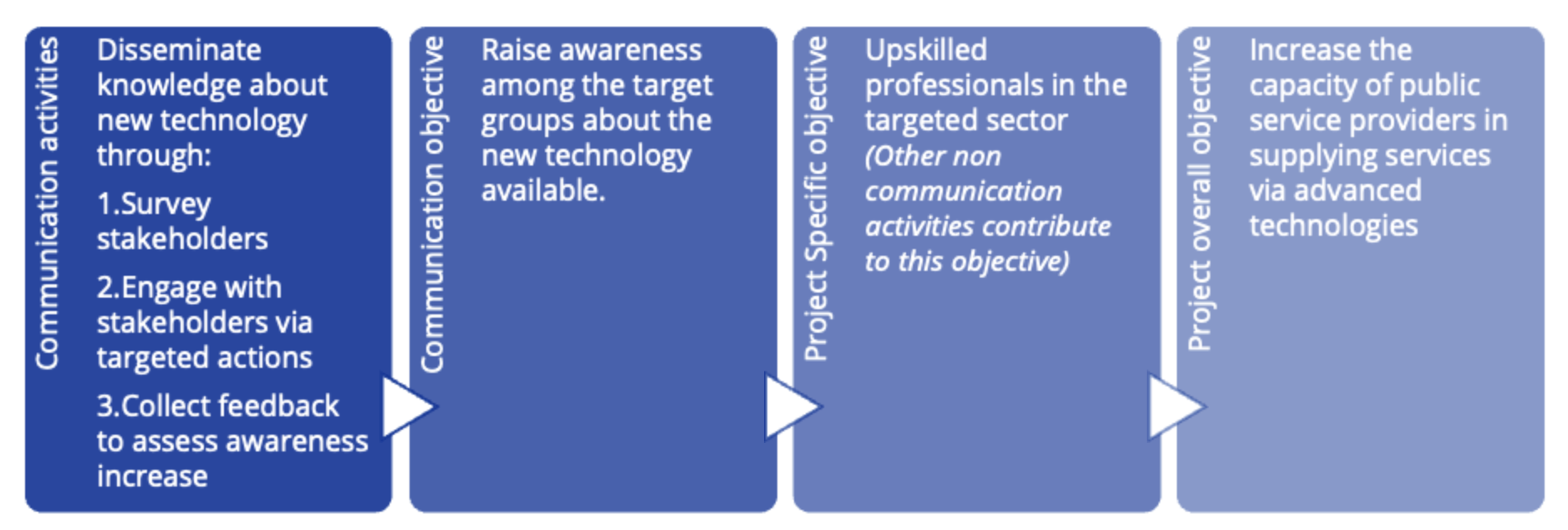2.5 Communication
2.5.1 The role of the project
The Northern Periphery and Arctic programme is part of the Interreg programmes funded by the European Union Cohesion Policy. Interreg programmes were established based on the belief that cooperation is key to sustainable and harmonious economic, social and territorial development.
For this reason, the European Commission continues placing emphasis on communicating results, hoping to increase awareness among citizens about the results achieved with European cooperation funding, attract more potential project partners and increase transparency.
In line with the Commission’s strategy, the Interreg NPA communication aim is to raise awareness about the Northern Periphery and Arctic Programme 2021-2027, its objectives and its outputs by engaging with (potential) beneficiaries, relevant stakeholders and the public.
Projects also have a role to play in reaching the programme results:
Projects form the link between the programme and the citizens in the NPA area
Project partners are located in the communities that the programme
wishes to reach. Project partners can communicate with the stakeholders, policy
makers and citizens in their own language.Projects produce tangible outputs that impact citizens
It is easier to communicate the results and benefits of transnational cooperation to
the citizens and stakeholders when you can show tangible outputs and improvements in the daily lives of end users.
For this reason, communication is an essential part of the project for the achievement of both the project and the programme's results.

Figure 7 - Why project communication is important.
When developing a project, applicants will have to describe the general approach to communication and detailed information on communication objectives and activities in each work package.
2.5.2 Communication approach
Each project must have a strategic approach to communication addressing internal information flows and external outreach efforts.
Internal communication describes who will coordinate project communication and how the involvement and contribution of all partners will be organised.
External outreach addresses communication measures and messages, as well as what languages, tools and channels will be used to engage with relevant stakeholders and support the uptake of project results.
A successful approach to communication brings added value and benefits to the project in terms of:
Better coordination between partners and better management,
Better project implementation,
Raised awareness among end users and target communities,
Better viability of the project outputs and therefore results,
More political support and support from citizens to ensure a longer lasting impact of the project and more future support,
Attracting more match funding and outside investments from participating organisations and other stakeholders.
2.5.3 Communication objectives and activities
Communication objectives and activities are to be described in the project Application Form.
For each relevant work package, the corresponding communication objective(s) should be described giving information about how communication work will contribute to the project specific objectives. To be able to meet the project objectives, the partners may need to engage with relevant stakeholders, for example through communication activities that:
raise awareness,
change attitudes or beliefs,
change behaviour.
Communication activities in each work package describe what needs to be done to raise awareness, change attitudes/beliefs/behaviours thereby contributing to the project specific objectives and ultimately, to the results sought by the project.

Figure 8 - From activities to change, a basic example how communication work supports project achievements
2.5.4. Good-to-know when planning resources for communication
All projects that receive European funding must comply with the publicity requirements
stipulated in the European regulations. These are briefly outlined below and further detailed in the implementation chapter.
Displaying the programme/project logo in a visible manner on any materials intended for the general public or for participants.
Providing on the partner’s official website or social media sites, a short description of the project;
Publicly displaying at least one poster of a minimum size A3 or equivalent electronic display, with information about the project and programme.
In addition to the regulatory requirements above, the following should be considered when planning activities and resources for project communication, except Preparatory projects.
Interreg NPA requirements
All Main projects are expected to:
Maintain and update the project mini-website, part of the programme website (currently under development).
Produce at least 2 media products outlining the project’s vision and achieved results;
Organise activities, events and any other relevant initiatives to ensure the engagement of relevant target groups across all participating countries and partners.
Have a social media presence.
Attend NPA event during the project lifetime
More detailed information about each of the points above is available in Chapter 4 – How to implement.
Budget sufficient resources
Sufficient budget for communication expertise and participation in events should be available at all partner organisations. The programme may ask the project representatives to present their project, results, and achievements at events.
Interreg NPA and other relevant events:
Participation in NPA annual events is recommended for all project partners. Such events take place usually in the autumn of each year in one of the NPA regions.
Lead partners are expected to attend Lead Partners seminars, indicatively 2 in the lifetime of a project, once at the JS premises, once in the programme area. A project and financial manager are usually invited. Potentially, meetings targeting Project Communication mangers will be organised back-to-back to LP Seminars once in a project lifetime.
All partners shall budget for participation in information and communication initiatives organised by Regional Contact Points in the NPA regions, indicatively once a year.
The programme encourages participation in Arctic and/or EU thematic events and competitions. This is an eligible project cost when relevant for the project objectives. The Interreg NPA programme also contributes to raising awareness about the role of the programme in EU Arctic Policy by facilitating synergies and clustering among Arctic and near-Arctic stakeholders in the Interreg Arctic Cooperation framework.
Project visual identity
Projects will not be expected to develop an own logo, website, and corporate image. Templates and a branding guidance will be provided by the Programme based on the Interreg Joint Branding initiative, in line with European regulations. Templates will include: a programme-project logo, a project mini-website as part of the main programme website, an A3 poster, and project branding guidelines.
Projects may decide to develop an own logo and website/portal. These projects will have to demonstrate the need for an own visual identity in relation to the strategic and durable achievement of results. This will have to be outlined in the Application form and prove to be a good fit within the project logic. Any own project logo or website will need to integrate the mandatory combined programme/project logo and will not replace the mini-website.
Open access results
Outputs and results of all Interreg NPA funded projects must be openly accessible, the results must be free of charge and available to anyone.
For this reason:
projects should plan for all outputs and results to be publicly available;
partners shall ensure a royalty-free, non-exclusive and irrevocable licence to use project outputs and communication materials, and any pre-existing rights attached to it, to the programme bodies and EU institutions. This shall not require significant additional costs or a significant administrative burden for the project partners or for the programme bodies.
To support a wide spread of the project deliverables and outputs, and to make them available to the public, the Interreg NPA programme and European Institutions will together with the project partners contribute to promoting project outputs and results.
